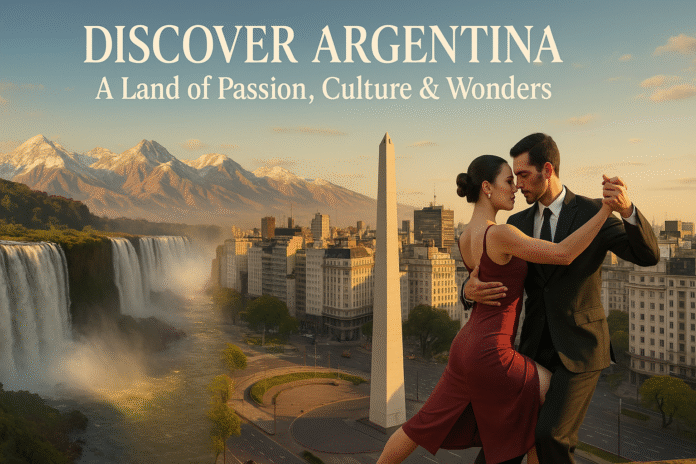Introduction
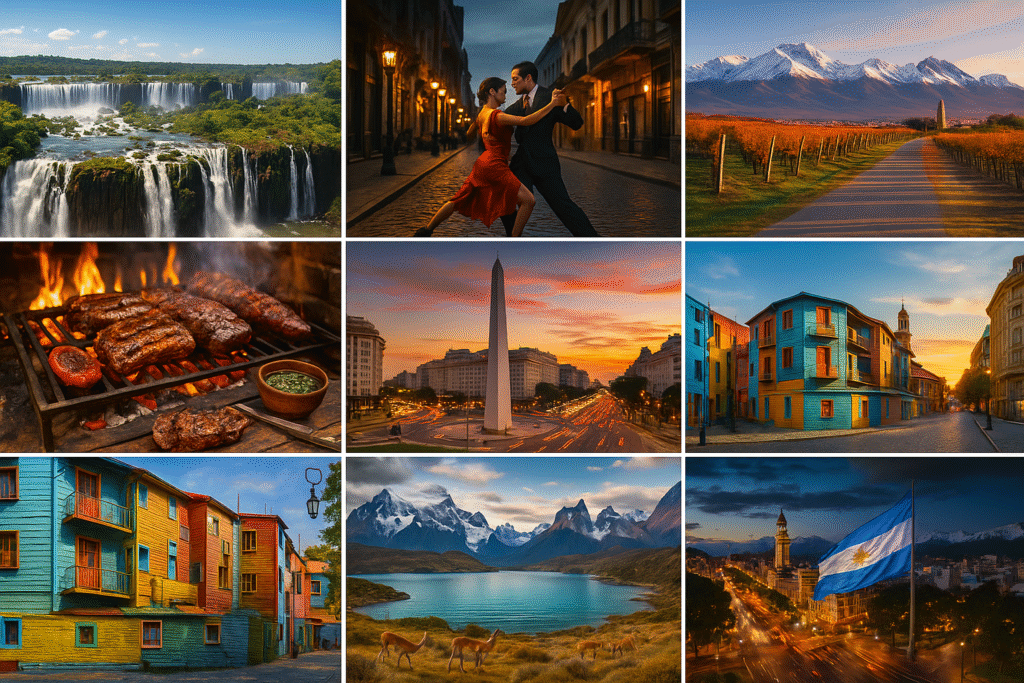
From the tropics to the tip of South America, Argentina is a nation of striking contrasts and a lively spirit that embraces natural wonders, urban sophistication, and cultural diversity. Argentina is a must-visit travel destination and a fascinating subject for historians, geographers, nature lovers, and culture vultures. It is well-known for its tango rhythms, beefy asados, football legends, and the breathtaking Andes mountain range.
There is something for every type of adventurer in this amazing land. Argentina makes a lasting impression on everyone who visits, whether it is through the breathtaking Patagonian glaciers, the roaring Iguazú Falls, the wine-filled Mendoza valleys, or the vibrant nightlife of Buenos Aires. It is a place where modern inventions coexist with ancient indigenous customs, and European elegance meets Latin American flair.
Argentina is a cultural powerhouse that is much more than just a place to visit, with its rich political past, revolutionary leaders, thriving arts scene, and internationally renowned literature. It’s also a land of extremes, where you can watch penguins waddling along the southern coasts and sip Malbec under desert skies in the west—all in one nation.
Argentina’s geography, historical landmarks, cultural manifestations, linguistic diversity, economic highlights, popular tourist destinations, and worldwide influence will all be covered in this comprehensive blog post. This thorough guide will provide insights into one of South America’s most fascinating countries, whether you’re planning a trip, conducting academic research, or just sating your curiosity.
Argentina’s Geographic Overview
Where is Argentina Located?
- Continent: South America
- Position: Southern half of South America, largely in the Southern Hemisphere
- Bordering Countries:
- Brazil (northeast)
- Bolivia (north)
- Paraguay (north)
- Chile (west)
- Uruguay (east)
- Brazil (northeast)
- Oceans: Atlantic Ocean (east)
- Latitude Range: From tropical north (Iguazú Falls) to subpolar south (Tierra del Fuego)
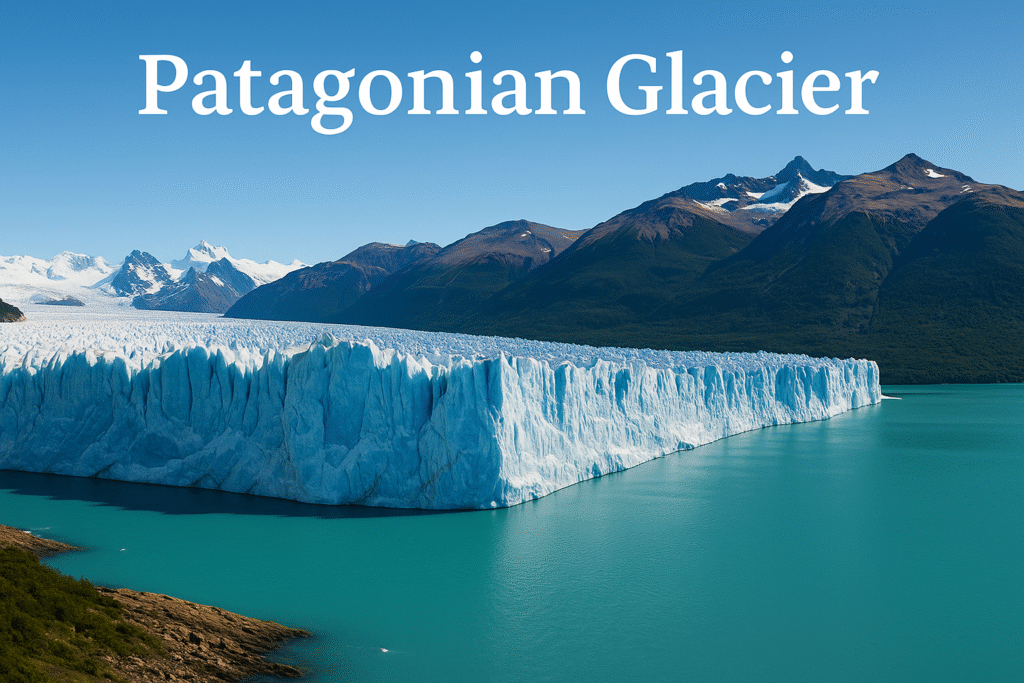
Topographical Highlights
- The country’s spine is formed by the western Andes Mountains.
- The central areas, which are the cattle farming heartland, are dominated by Pampas grasslands.
- The southern region of Patagonia features snow-capped peaks, deserts, and glaciers.
- Fertile lowlands can be found in the northern regions of Mesopotamia and Gran Chaco.
A Journey Through Argentina’s History
Pre-Columbian and Colonial Times
- The area was inhabited by indigenous groups such as the Diaguita, Mapuche, and Guaraní.
- Juan Díaz de Solís, a Spanish explorer, arrived in 1516.
- Pedro de Mendoza founded Buenos Aires in 1580.
- Prior to Argentina’s struggle for independence, Spain ruled.
Independence and Nation Building
- On July 9, 1816, Argentina proclaimed its independence.
- Civil wars, disputes with native populations, and consolidation all occurred during the 19th century.
- Argentina was among the richest countries in the world at the beginning of the 20th century.
The Modern Era
- a turbulent 20th century marked by populism, economic crises, and military dictatorships.
- return to democracy in 1983 following the overthrow of the military dictatorship.
- economic difficulties that persisted, but democratic institutions held up well.
Argentina’s Culture: A Fusion of Traditions
Language and Identity
- Official Language: Spanish (Rioplatense dialect with Italian influence)
- Other languages: Quechua, Mapudungun, Guaraní, and English (in tourist regions)
Cuisine

- Asado (BBQ): A national pastime
- Pastries stuffed with cheese, meat, or vegetables are called empanadas.
- Dulce de Leche: A sweet spread that resembles caramel
- Mate: A social custom of drinking bitter herbal tea
Music and Dance

- Tango: UNESCO Intangible Cultural Heritage; late 19th-century Buenos Aires birthplace
- In the provinces, folk music such as chacarera and zamba is very popular.
Literature and Arts
- Famous writers like Julio Cortázar and Jorge Luis Borges call this place home.
- thriving theatre industry, particularly in Buenos Aires
- vibrant murals and street art throughout large cities
Festivals
- Gualeguaychú’s Carnaval
- Mendoza’s Grape Harvest Festival, or Fiesta Nacional de la Vendimia
- International Tango Festival in Buenos Aires
Argentina’s Economy and Resources
Economic Overview
- Type: Mixed economy
- The Argentine Peso (ARS) is the currency.
- Agriculture, mining, manufacturing, tourism, and technology are the main industries.
Key Exports
- Soybeans, corn, wheat
- Wine (notably Malbec from Mendoza)
- Beef
Challenges and Opportunities
- Frequent crises of debt and inflation
- a resource-rich nation with enormous potential
- Growing the tech and renewable energy sectors
Major Cities of Argentina
Buenos Aires
- The largest and capital city
- “The Paris of South America” is a nickname.
- renowned for its tango, nightlife, and architecture
Córdoba
- The second-biggest city
- A university town with a long history of colonisation
Rosario
- On the Paraná River
- Lionel Messi and Che Guevara’s birthplace
Mendoza
- Argentina’s wine capital
- Mount Aconcagua is the starting point for Andean adventures.
Bariloche
- An Alpine town renowned for its chocolate, skiing, and Swiss-style buildings
Ushuaia
- Southernmost city in the world
- Gateway to Antarctica
Top Tourist Attractions in Argentina
Natural Wonders
- One of the biggest and most beautiful waterfalls in the world is Iguazú Falls.
- Los Glaciares National Park’s Perito Moreno Glacier is a dynamic glacier.
- The tallest peak outside of Asia is Mount Aconcagua.
- The Valdés Peninsula is a sanctuary for marine life, including sea lions, penguins, and whales.
Urban Adventures
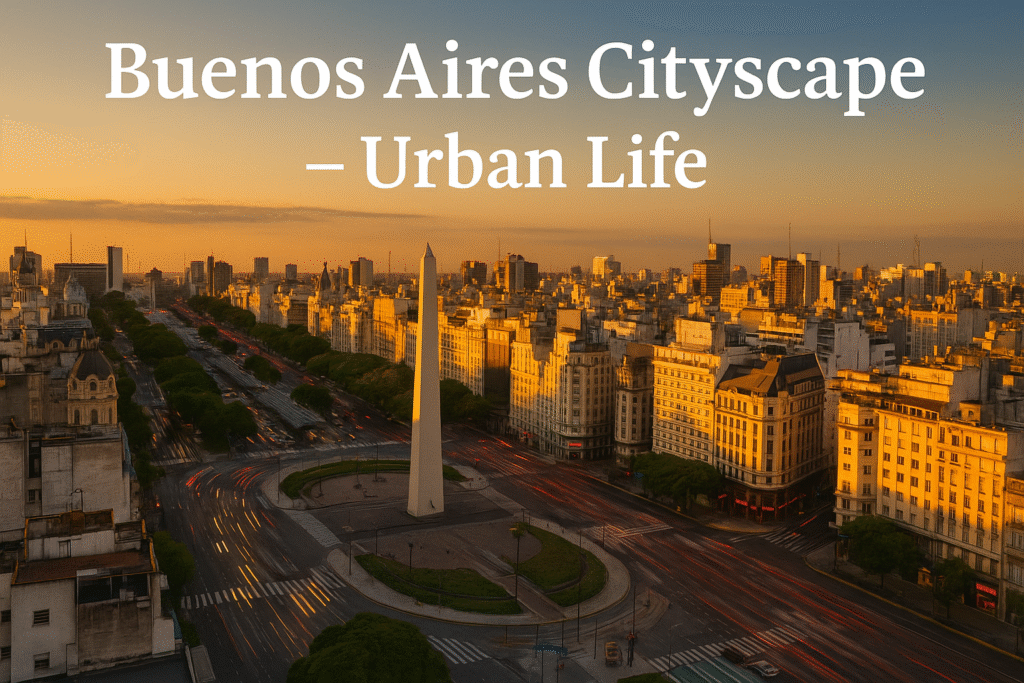
- Recoleta Cemetery: Eva Perón’s final resting place
- Buenos Aires’ cultural centre is San Telmo Market.
- La Boca: A vibrant neighbourhood with a history of football and tango
Wine Tourism
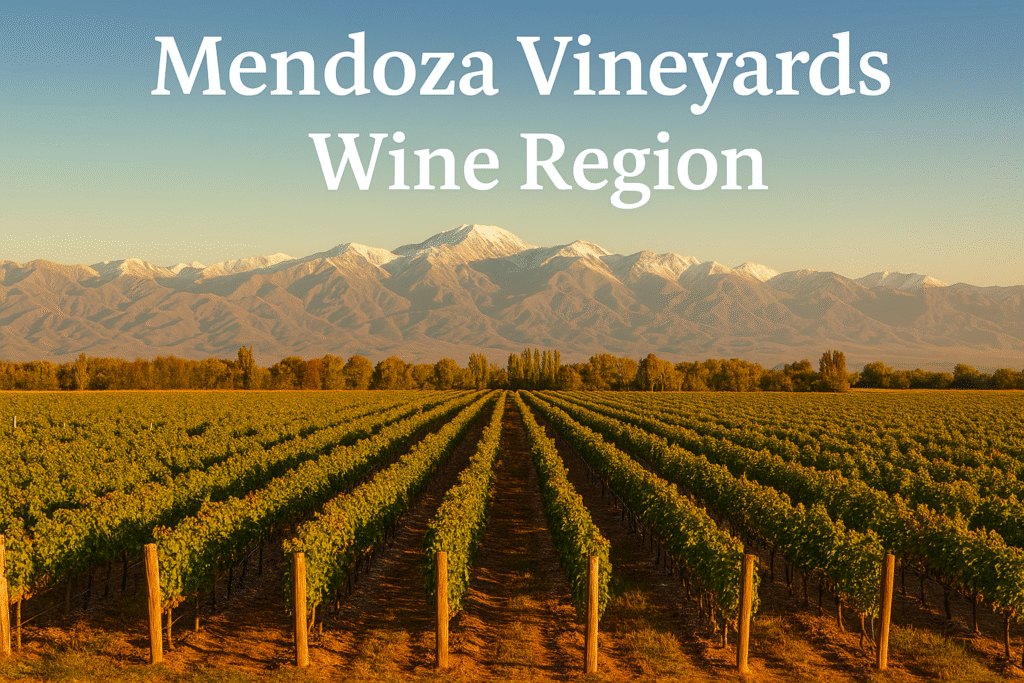
- Wineries in Mendoza provide tours and tastings with Andean scenery.
Adventure Tourism
- Trekking in Patagonia
- Skiing in Bariloche
- White-water rafting in San Juan
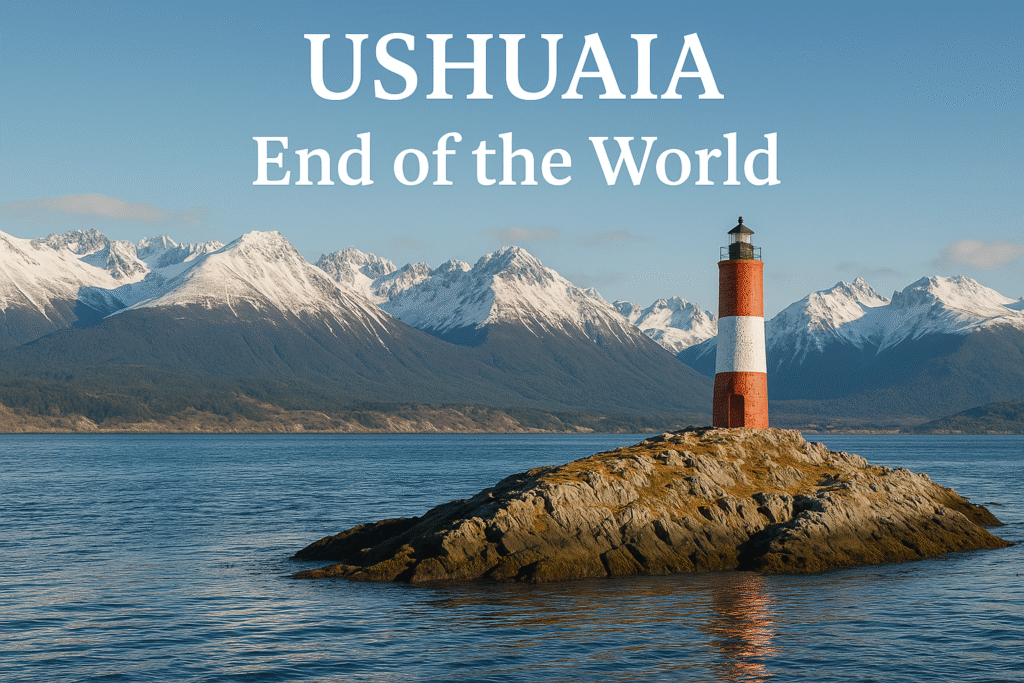
Language, Religion, and Society
Religion
- Predominantly Roman Catholic
- Also home to Protestant, Jewish, and Muslim communities
Education & Literacy
- High literacy rate (~99%)
- Strong university system
Social Life
- Family-centered society
- Extended meals and social gatherings
Argentina in the Global Context
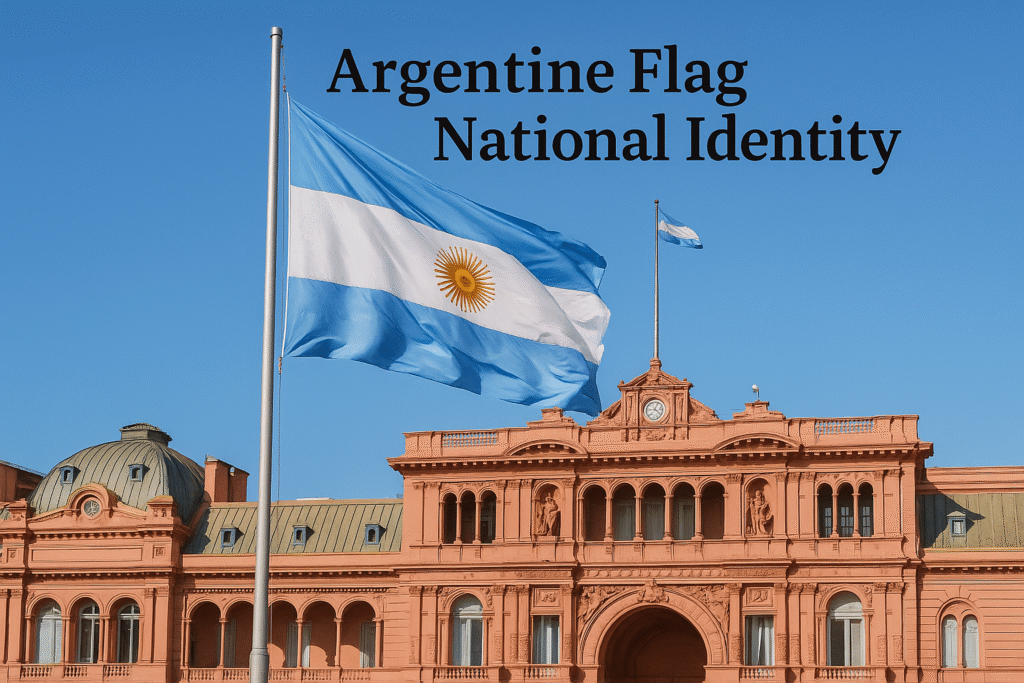
- Continent: South America
- Member of the United Nations: Yes (since 1945)
- Active in Mercosur, G20, UNESCO, and CELAC
- Plays a regional leadership role in Latin America
Fascinating Facts About Argentina
- The location of Ushuaia, the world’s southernmost city
- The first nation to employ fingerprinting in criminal investigations
- gave world football players like Lionel Messi and Diego Maradona
- Here are the largest dinosaur fossils ever found.
- Manuel Belgrano designed the Argentine flag in 1812.
Summary
Argentina’s geographical, cultural, and historical diversity enthrals. There is something for every traveler and learner in the country, from the wilds of Tierra del Fuego to the lush wine lands of Mendoza, and from the rhythmic tango of Buenos Aires to the icy cliffs of Patagonia. It has a rich history, a vibrant present, and a bright future.
Argentina stands tall as a symbol of tenacity, beauty, and the human spirit, whether you’re considering a trip there, studying there, or are simply interested in world culture.
Stay curious. Stay inspired. Viva Argentina!
🌍 Geographical and Country Profile
- CIA World Factbook – Argentina
(Reliable country overview: geography, demographics, economy, and politics) - National Geographic – Argentina
(Travel inspiration and natural wonders) - UNESCO World Heritage Sites – Argentina
(Official list of Argentina’s cultural and natural UNESCO sites)
🏛️ History and Culture
- History.com – Argentina
(Summarized timeline of Argentine history) - BBC Country Profile – Argentina
(Up-to-date political and historical insights) - Instituto Nacional de Estadística y Censos (INDEC)
(Argentina’s official statistics bureau – Spanish only)
🎨 Culture, Music & Language
- UNESCO Intangible Heritage – Tango
(Tango’s cultural significance and its global recognition) - Mate Culture
(Insight into the ritual of drinking mate in Argentina) - Ethnologue – Languages of Argentina
(Detailed language data, including indigenous tongues)
📈 Economy and Industry
- World Bank – Argentina Overview
(Economic data and development indicators) - Invest Argentina
(Government portal for foreign investment) - OEC – Argentina Trade Data
(Interactive data on Argentina’s exports and imports)
🏙️ Tourism and Travel
- Official Argentina Tourism Website
(Government tourism portal with top destinations and tips) - Lonely Planet – Argentina
(Traveler’s guide with reviews and experiences) - TripAdvisor – Argentina
(User-generated reviews of cities, restaurants, hotels, and tours)
🇺🇳 Global Standing & International Relations
- United Nations – Argentina Member Profile
(UN participation and history)
G20 Members – Argentina
(Argentina’s role in global economic discussions)



